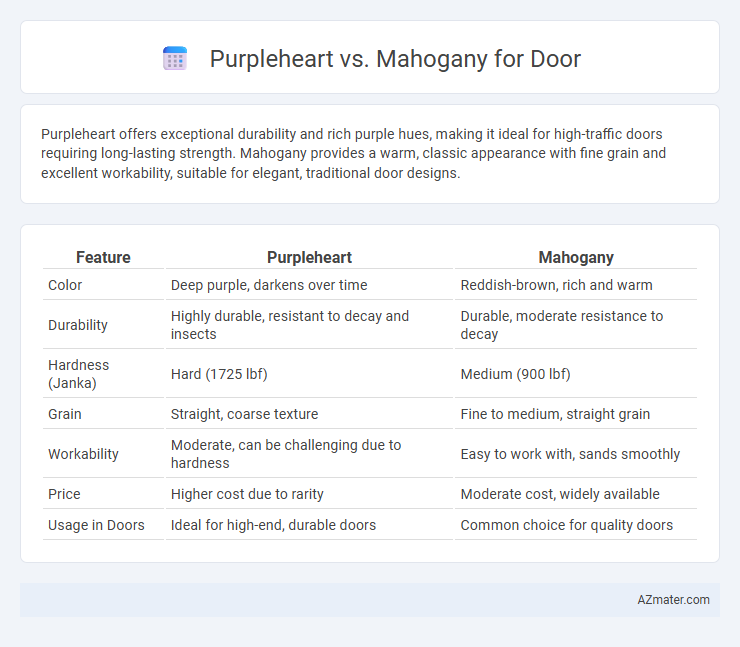Purpleheart offers exceptional durability and rich purple hues, making it ideal for high-traffic doors requiring long-lasting strength. Mahogany provides a warm, classic appearance with fine grain and excellent workability, suitable for elegant, traditional door designs.
Table of Comparison
| Feature | Purpleheart | Mahogany |
|---|---|---|
| Color | Deep purple, darkens over time | Reddish-brown, rich and warm |
| Durability | Highly durable, resistant to decay and insects | Durable, moderate resistance to decay |
| Hardness (Janka) | Hard (1725 lbf) | Medium (900 lbf) |
| Grain | Straight, coarse texture | Fine to medium, straight grain |
| Workability | Moderate, can be challenging due to hardness | Easy to work with, sands smoothly |
| Price | Higher cost due to rarity | Moderate cost, widely available |
| Usage in Doors | Ideal for high-end, durable doors | Common choice for quality doors |
Introduction: Purpleheart vs Mahogany for Doors
Purpleheart and Mahogany are premium hardwoods widely used in door construction due to their durability and aesthetic appeal. Purpleheart, known for its distinctive rich purple hue, offers exceptional resistance to wear and decay, making it ideal for high-traffic entryways. Mahogany, prized for its warm reddish-brown color and fine grain, delivers superior stability and smooth finish, ensuring elegant and long-lasting door installations.
Wood Origin and Characteristics
Purpleheart, sourced primarily from Central and South American rainforests, is known for its vibrant purple hue that deepens with age, making it a distinctive choice for doors. Mahogany, originating from tropical regions of the Americas and Africa, offers a rich reddish-brown color and exceptional durability with a fine, straight grain. Both hardwoods provide strong resistance to decay and wear, but Purpleheart is notably harder, while Mahogany is prized for its workability and classic aesthetic appeal.
Appearance and Color Differences
Purpleheart wood showcases a striking deep violet hue that darkens to a rich purple-brown over time, creating a bold and unique appearance ideal for accent doors. Mahogany, known for its warm reddish-brown tones with subtle golden undertones, offers a classic and elegant look that deepens with age, providing timeless beauty. The vivid, exotic coloration of Purpleheart contrasts sharply with the smooth, traditional reddish warmth of Mahogany, catering to different aesthetic preferences in door design.
Durability and Hardness Comparison
Purpleheart wood boasts a Janka hardness rating of approximately 2,520, significantly surpassing Mahogany's rating around 800-900, indicating superior resistance to dents and scratches for door applications. Purpleheart offers exceptional durability with strong resistance to decay and insect damage, making it ideal for exterior doors exposed to harsh weather. While Mahogany provides good durability and a classic appearance, Purpleheart's hardness and longevity make it a more robust choice for high-traffic or heavy-use doors.
Weather Resistance and Longevity
Purpleheart exhibits superior weather resistance compared to mahogany, thanks to its dense, oily grain that naturally repels moisture and insect damage, making it ideal for exterior doors in varying climates. Mahogany, while durable and stable, is more susceptible to warping and requires regular sealing to maintain its longevity under harsh weather conditions. Over time, Purpleheart's exceptional hardness and rot resistance contribute to a longer lifespan for doors exposed to sun, rain, and temperature fluctuations, outperforming mahogany in outdoor durability.
Workability and Ease of Installation
Purpleheart offers moderate workability with a dense, hard texture that requires sharp tools and patience, while Mahogany is known for its exceptional workability due to a straight grain and softer density, making it easier to cut, shape, and sand. The installation process with Purpleheart demands more effort to countersink screws and achieve smooth finishes, whereas Mahogany allows faster installation and easier adjustments because of its uniform consistency. Both woods provide durability, but Mahogany's ease of machining reduces installation time and labor costs significantly compared to Purpleheart.
Cost and Availability
Purpleheart wood is generally more expensive than mahogany due to its rarity and limited availability, often sourced from Central and South America. Mahogany is widely available and more cost-effective, making it a popular choice for doors in both residential and commercial applications. The price difference is influenced by the sustainable harvesting and import restrictions on purpleheart, whereas mahogany's established supply chains support lower costs and easier procurement.
Maintenance Requirements
Purpleheart doors require minimal maintenance due to their natural resistance to decay, insects, and moisture, making them ideal for exterior use. Mahogany doors demand regular upkeep, including sealing or oiling, to protect against humidity and potential warping or discoloration over time. Both woods benefit from periodic cleaning, but purpleheart's durability reduces the frequency and intensity of maintenance efforts.
Environmental Impact and Sustainability
Purpleheart wood is known for its exceptional durability and natural resistance to decay, making it a long-lasting choice that reduces the need for frequent replacements. Mahogany, often harvested from slow-growing tropical forests, faces sustainability challenges due to overexploitation and habitat loss, though responsibly sourced FSC-certified mahogany offers a more eco-friendly option. Choosing Purpleheart from managed plantations or FSC-certified mahogany can minimize environmental impact while providing strong, beautiful materials for door construction.
Which Wood is Best for Your Door?
Purpleheart and Mahogany are both excellent choices for doors, but their suitability depends on specific needs and aesthetics. Purpleheart offers exceptional durability and vibrant purple hues that deepen with age, making it ideal for statement doors requiring high resistance to wear and weather. Mahogany provides a classic, warm appearance with fine grain and superior workability, perfect for elegant, traditional doors needing stability and refined finishes.

Infographic: Purpleheart vs Mahogany for Door
 azmater.com
azmater.com